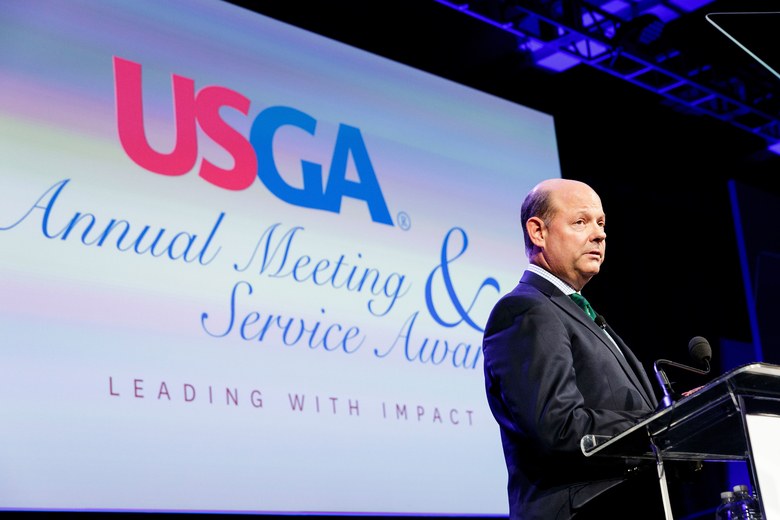Copyright USGA/John Mummert
By Ryan Herrington
SAN ANTONIO — From allowing flagsticks to stay in while putting, to the prohibition of caddies standing behind players, to the knee-height requirement for dropping a ball, the new Rules of Golf have been among the most hotly debated topics in the game to date in 2019. At no time did Mike Davis get a better appreciation for this fact than earlier this month, when the USGA CEO had the chance for the first time to play in the AT&T Pebble Beach Pro-Am—and in the process place himself in the line of fire from tour professionals.
“I was hitting some balls on the range [one day],” Davis recalled on Saturday ahead of his State of the Association speech at the USGA Annual Meeting at the J.W. Marriott Resort & Spa. “And without naming names, a couple of big-name players were on either side of me. And all of a sudden the conversation was ‘I don’t get this dropping from your knee. What gives?’”
Davis gladly talked to them about the changes and tried to explain their rationale, as have USGA and R&A officials who have attended professional events around the world this year in an attempt to educate the players on the most sweeping changes to the rule book in decades. Suffice it to say, some of the discussions have been lively.
Given criticism voiced by various pros on social media about some of the changes, you’d think the USGA might be upset with how the modernized Rules have been rolled out. Not so, says Davis.
“From my perspective, I would say by and large they’ve been a huge success,” Davis said. “They did exactly what we wanted them to do, which was really simplify the understanding and make them easier to apply.”
That doesn’t mean the process hasn’t come with some angst. Hearing tour pros rail against the USGA is nothing new. But USGA officials have tried to address the issues quickly and provide players background for the changes in hopes that a better understanding of the thought process will assuage their concerns.
“When you actually take them through this is why, it’s always a light-bulb moment,” Davis said. “‘Oh, I didn’t realize that.’ And I think that’s the frustration that there is. You know it would have been nice if you actually asked them why … but listen, it’s the world we live in.”
The most recent case of an upset tour pro is Rickie Fowler. On Friday during the second round of the WGC-Mexico Championship, he shanked his second shot on the 10th hole out of bounds. He then mistakenly dropped his replacement ball not from knee height, as the new Rules require, but from the old standard of shoulder length. This resulted in a one-stroke penalty.
Afterwards, Fowler called the change to the rule “terrible.” “It’s on me. I took the shot. It was no big deal,” Fowler told reporters. “But I think with the new rules that have been put in place, it’s not doing any favours for our sport.”
Thomas Pagel, USGA senior managing director, governance, said that the USGA intends to reach out to Fowler after this weekend to discuss the issue directly and attempt to explain why the change has been made. Pagel, who was on-site at the first PGA Tour event of 2019 and spoke to players at length about the rules changes, said that the new drop procedure was an area where the USGA tried to emphasize to the tour pros to be particularly mindful of, knowing that old habits can die hard.
Despite the criticism, Pagel says that the USGA and R&A are taking a long approach to the new Rules. “We went through a long process, seven years in the making,” Pagel said. “We engaged 30,000-plus golfers as part of a feedback period. We released the rules in advance and we went in and further revised them. We gave plenty of runway for people to jump in and learn.
“I would say in the application of the rules, we remain committed to the rules as they are,” Pagel said. “If we learn something, if we realize that a rule is producing bad outcomes, we will adjust.”
Specifically, Pagel noted the USGA’s clarification on the caddie line-up rule, which created confusion during the Waste Management Phoenix Open.
But don’t expect the USGA to make any short-term changes for the sake of appeasement.
“We just need to remain vigilant with our conversations,” Pagel said, “and make sure we’re out there and have a presence with the players at the highest level and we’re able to have those conversations, to explain a little of the ‘why’ frankly in informal settings. If they understand the why, perhaps there’s a thought or two before it hits social media.”









